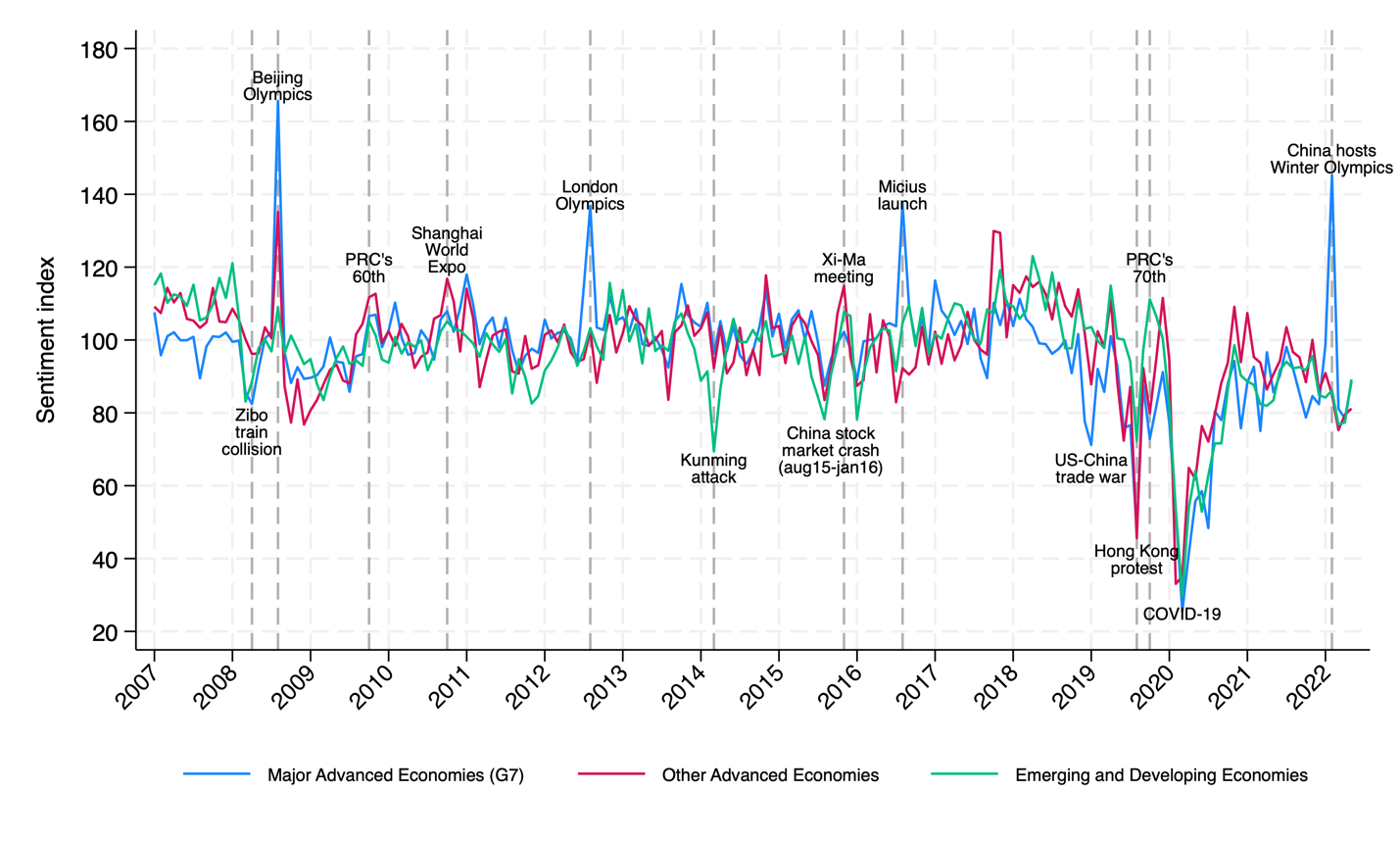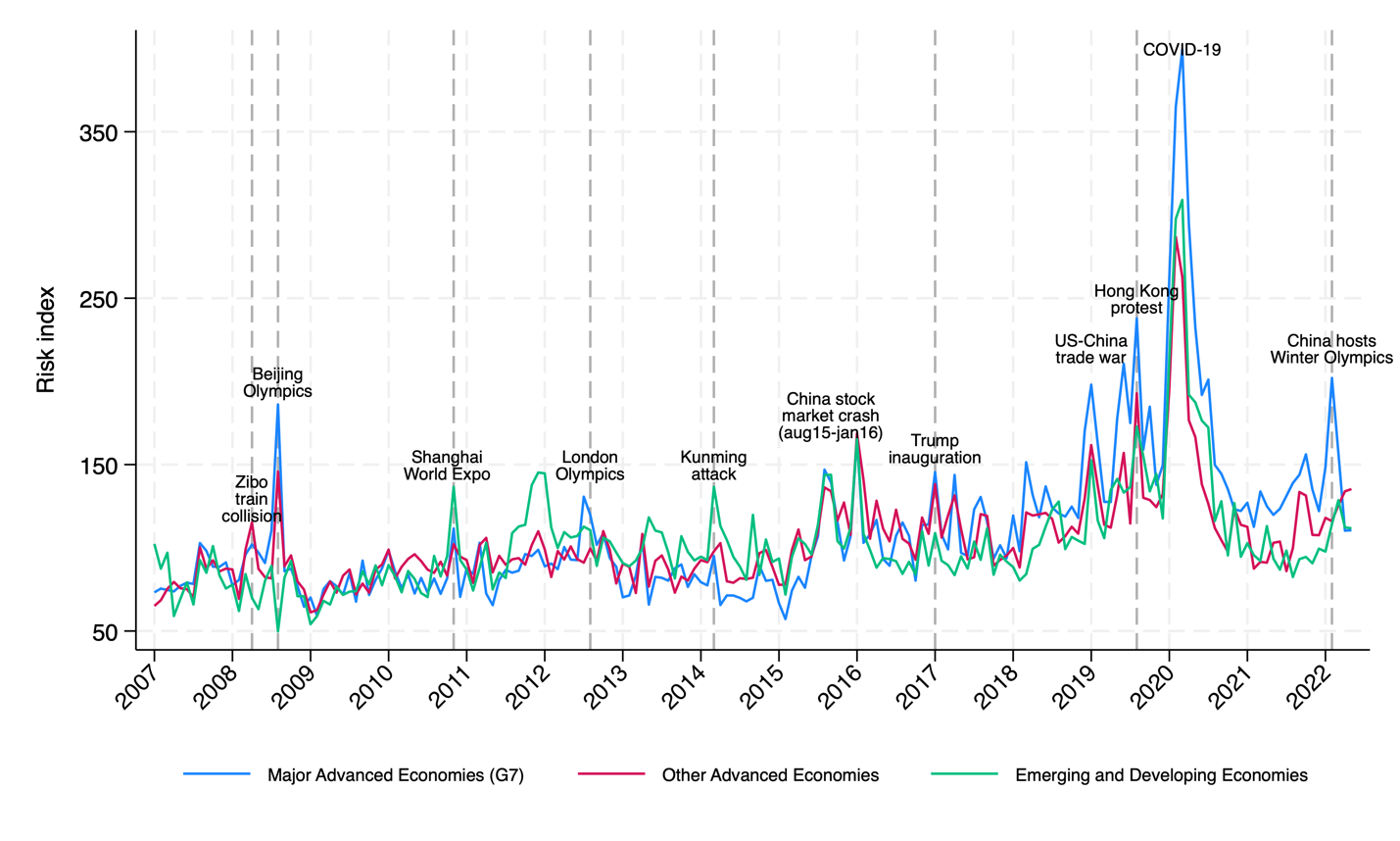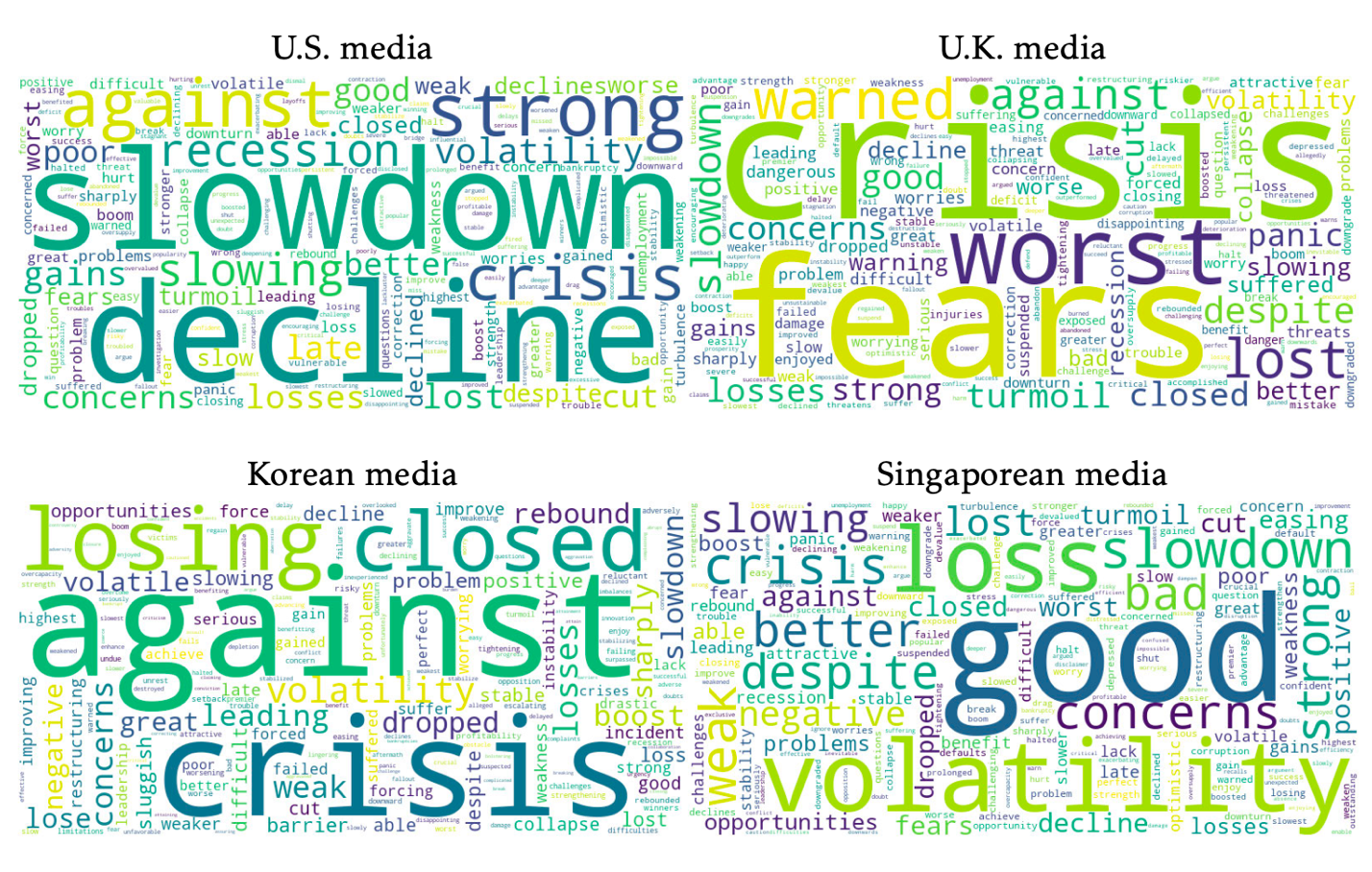Beyond the Fundamentals: How Media-Driven Narratives Influence Cross-Border Capital Flows
We provide the first empirical evidence on how media-driven narratives influence cross-border institutional investment flows. Applying natural language processing techniques to 1.5 million newspaper articles, we document substantial cross-country variation in sentiment and risk indices constructed from domestic media narratives about China in 15 countries. These narratives significantly affect portfolio flows, even after controlling for macroeconomic and financial fundamentals. This impact is smaller for investors with greater familiarity or private information about China and larger during periods of heightened uncertainty. Political and environmental narratives are as influential as economic narratives. Investors react more sharply to negative narratives than positive ones.


In an era where the volume of available data grows exponentially while attention spans grow shorter, the narratives shaped by media can hold immense power in influencing decisions. This is particularly relevant for global investors, who often have to parse an overwhelming amount of complex information while thinking about cross-border portfolio allocation. For investments in China, media narratives might play an even more important role given the opacity of policymaking, inconsistent data availability, and barriers such as language and regulatory complexity. These factors might make it harder for international investors to access and interpret reliable market information directly. As a result, media narratives might become the primary lens through which investors evaluate opportunities and risks in the Chinese market. Given China’s growing importance as a destination for global capital flows, understanding how these narratives shape investment flows is essential for investors and policymakers alike.
In our paper, we provide the first empirical examination of whether domestic news media–based narratives about the destination country affect cross-border investment flows. Specifically, we study whether domestic media narratives influence institutional investors’ portfolio flows to China.
Measuring Media Narratives at the Micro Level
Media-driven narratives can influence investors' decisions by shaping sentiments toward a country or altering the perceived risk of investing in it or both. To capture these two dimensions, we construct country-level measures of narrative-based sentiment and risk perception about China using natural language processing methods and full text from 1,454,645 news articles published in 38 English newspapers across 15 economies over the period of 2007–2022. We include both financial as well as general news media in the sample, depending on data availability in the ProQuest database. The sentiment index reflects the intensity of positive and negative sentiments in local newspapers about China, while the risk index captures variations in risk perception regarding investing in China. Figure 1 shows both sentiment and risk indices by country groups, illustrating their changes in response to major China-related events.
Figure 1: Sentiment index and risk index
(A)Sentiment index

(B)Risk index

Notes: This figure plots the average time series of the (A) sentiment index and (B) risk index, grouped by Major Advanced Economies (G7), Other Advanced Economies, and Emerging and Developing Economies.
Media Narrative Variations Across Countries
Our media-driven narrative measures exhibit significant heterogeneity in the cross-section. These variations can be attributed to differential coverage of concurrent events related to China as well as differences in country-level heterogeneity in the description of the same event in the local news media. For example, media outlets created different narratives about the 2016 stock market crash in China. Figure 2 displays sentiment word clouds for the China stock market collapse in January 2016, as reported by media outlets in the US, the UK, Korea, and Singapore. US and UK media expressed relatively more negative sentiments toward the China stock market crash compared to media in Singapore. Furthermore, US coverage emphasized concerns about a broader economic slowdown and potential recession, while UK media focused more heavily on market-wide fears, employing strongly negative terms such as “worst.” Although Singaporean media also adopted a negative tone, they used more moderate language.
Figure 2: Sentiment word cloud: China stock market crash (Jan 2016)

Notes: This graph plots the sentiment word cloud in the news media of the US, UK, Korea, and Singapore, constructed using all the news articles with the keyword “China” and “stock” in January 2016. The US media include the Wall Street Journal, New York Times, Washington Post, USA Today, Boston Globe, and Los Angeles Times. The UK media include the Daily Mail, Daily Telegraph, Daily Mirror, and Evening Standard. The Korean media include the Korea Times, and the Singaporean media include the Straits Times and Business Times. The sentiment words are from Loughran and McDonald (2011). We rank the bigrams by frequency to construct the word cloud.
How Media-Driven Narratives Influence Cross-Border Capital Flows
We find that changes in media sentiment and risk narratives have a measurable impact on cross-border investment flows. We use fund-level portfolio holdings data to study how local media narratives about China in investors’ home country affects their investment flows to China, after controlling for standard macroeconomic and financial market variables that can potentially affect flows, including the quarterly GDP growth difference between China and the fund’s domicile country, exchange rate appreciation of China, the interest rates differential between China and the domicile country, and China’s equity market performance, measured using the return and volatility of the market index. We find that changes in media sentiment and risk narratives have a measurable impact on cross-border investment flows even after including these macroeconomic and financial market controls. A one standard deviation increase in positive media sentiment leads to a 2.3% quarterly rise in institutional investors’ investments into China, while a similar increase in risk perception results in a 2.1% decline. These effects occur independently of macroeconomic fundamentals, showing that narratives often operate as an independent and influential driver of investment decisions. The idea is that the risk and sentiment indexes include two components. One component that changes because of the actual change in the underlying economic fundamentals of China and this component would be the same across countries. Another component captures differences in the interpretation of the underlying economic event and this component would differ across countries. Our cross-sectional analysis relies on exploiting this heterogeneity in local media narratives that arises from differences in the media’s perception/interpretation of the underlying economic event. In this way, our results capture an additional mechanism—local media narratives—that drive capital flows, in addition to the economic fundamentals.
The extent to which media narratives influence investors depends significantly on how these narratives impact their information sets, which includes both availability of data about China and interpretation of this data. Media narratives affect the information set of investors either by alleviating frictions in accessing information or by making it easier to interpret available information. Specifically, investors who are less familiar with China or lack direct access to market data are particularly susceptible to the influence of these narratives, relying heavily on media coverage to interpret risks and opportunities. We also find that investors’ reliance on news media narratives increases in periods of high uncertainty as it is precisely in those periods that interpretation of available market data is more difficult.
Interestingly, we find that political and environmental narratives are just as influential as economic ones. In cases where standardized or easily accessible data is unavailable, investors depend on media narratives to fill the gaps, highlighting the critical role of storytelling in areas like geopolitics and sustainability. For instance, coverage of China’s environmental policies or its political developments can prompt significant shifts in capital allocation, beyond flows prompted by the direct effect of those policies on economic activity. We also find an asymmetry in how investors respond to media narratives. Negative stories exert a much greater influence than positive ones, reflecting the media’s inherent bias toward adverse events and the human tendency to react more strongly to negative events. This dynamic can lead to heightened market volatility and overreactions, particularly in emerging economies like China, for which local media in investors’ home country is often cautious in interpreting positive financial market performance, leading to a skeptical tone in the reporting of events related to China, where narratives may often diverge from actual market conditions.
Policy Implications
For policymakers in emerging markets, the findings underscore the importance of transparency and data accessibility. Providing consistent, multilingual, and reliable market information can reduce reliance on media narratives, fostering a more stable and appealing environment for foreign investors.
References
Agarwal, Isha, Wentong Chen, and Eswar S. Prasad. 2025. “Beyond the Fundamentals: How Media-Driven Narratives Influence Cross-Border Capital Flows.” National Bureau of Economic Research Working Paper No. 33159. https://www.nber.org/papers/w33159.
Editorial Board. 2015. “China’s Unsettling Stock Market Boom.” New York Times, June 15. https://www.nytimes.com/2015/06/15/opinion/chinas-unsettling-stock-market-boom.html.
Editorial Board. 2015. “China’s Economy Far from Sputtering. Massive Bull Run in Hong Kong Market May Signal Good Times Ahead.” Straits Times, April 19.
Loughran, Tim, and Bill McDonald. 2011. “When Is a Liability Not a Liability? Textual Analysis, Dictionaries, and 10-Ks.” Journal of Finance 66 (1): 35–65. https://doi.org/10.1111/j.1540-6261.2010.01625.x.

Latest
Most Popular
- VoxChina Covid-19 Forum (Second Edition): China’s Post-Lockdown Economic Recovery VoxChina, Apr 18, 2020
- China’s Great Housing Boom Kaiji Chen, Yi Wen, Oct 11, 2017
- China’s Joint Venture Policy and the International Transfer of Technology Kun Jiang, Wolfgang Keller, Larry D. Qiu, William Ridley, Feb 06, 2019
- Wealth Redistribution in the Chinese Stock Market: the Role of Bubbles and Crashes Li An, Jiangze Bian, Dong Lou, Donghui Shi, Jul 01, 2020
- The Dark Side of the Chinese Fiscal Stimulus: Evidence from Local Government Debt Yi Huang, Marco Pagano, Ugo Panizza, Jun 28, 2017
- What Is Special about China’s Housing Boom? Edward L. Glaeser, Wei Huang, Yueran Ma, Andrei Shleifer, Jun 20, 2017
- Privatization and Productivity in China Yuyu Chen, Mitsuru Igami, Masayuki Sawada, Mo Xiao, Jan 31, 2018
- Evaluating Risk across Chinese Housing Markets Yongheng Deng, Joseph Gyourko, Jing Wu, Aug 02, 2017
- How did China Move Up the Global Value Chains? Hiau Looi Kee, Heiwai Tang, Aug 30, 2017
- China’s Shadow Banking Sector: Wealth Management Products and Issuing Banks Viral V. Acharya, Jun Qian, Zhishu Yang, Aug 09, 2017




 Facebook
Facebook  Twitter
Twitter  Instagram
Instagram WeChat
WeChat  Email
Email 


